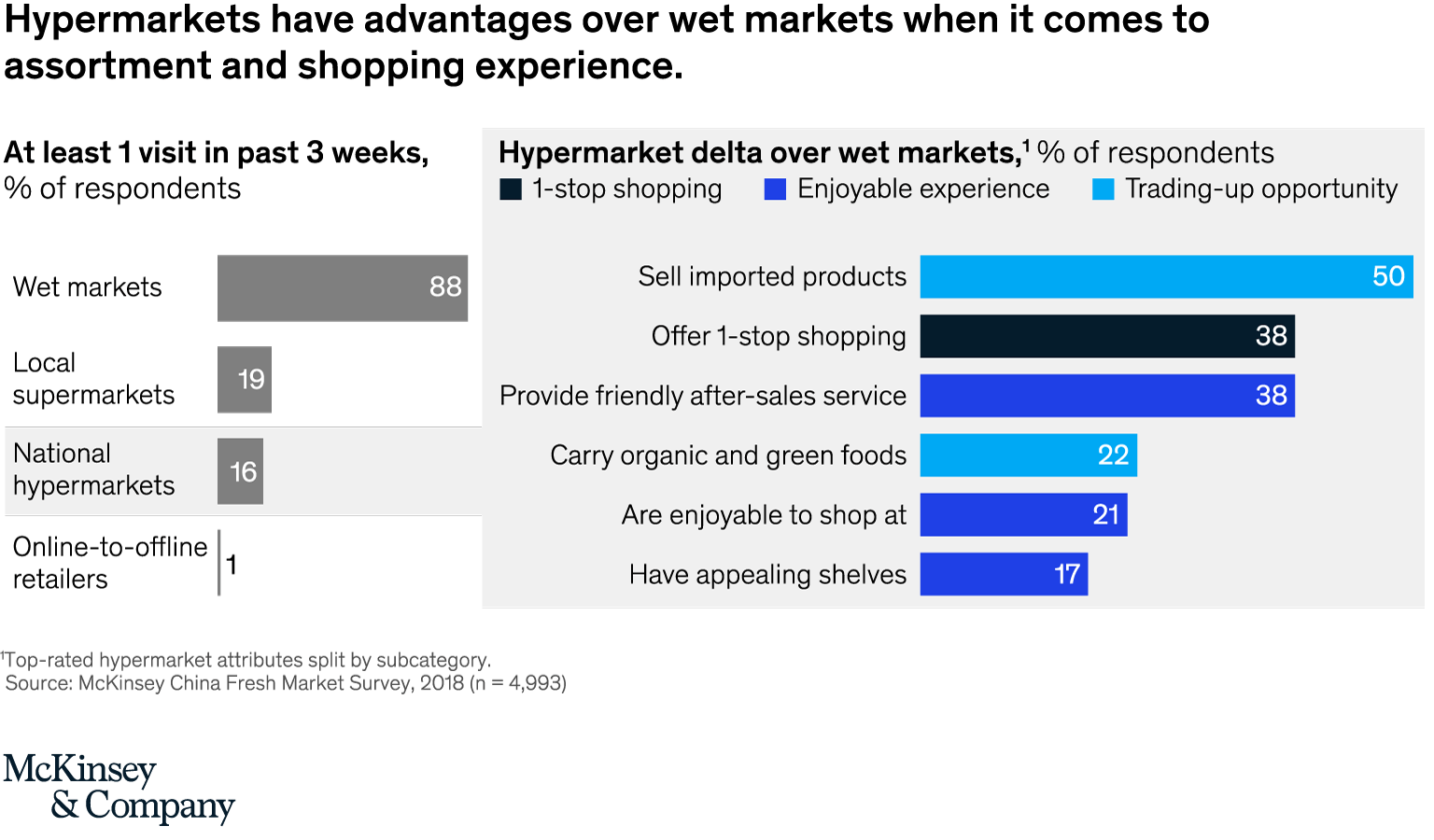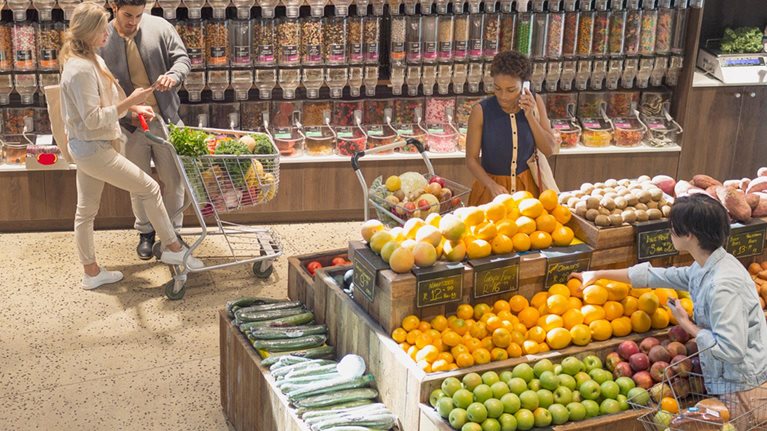Around the world, leading grocery retailers are differentiating themselves and attracting shoppers to their stores by investing in their fresh-food departments. Fresh food, after all, has a high basket penetration and is a big driver of customer loyalty. It also has a strong halo effect: if shoppers are satisfied with a retailer’s fresh offerings, their perception of the retailer’s other departments improves as well, resulting in more customer traffic and higher overall sales for the retailer. And fresh winners have outperformed the competition in profitability.1
In China, however, most hypermarket and supermarket chains haven’t gained much ground in the battle for the fresh-food shopper. Most Chinese consumers still prefer to buy fresh food from wet markets, where they can haggle over prices—a beloved cultural practice that isn’t part of the shopping experience at modern grocery stores. Furthermore, Chinese shoppers perceive the products sold in wet markets as being truly fresh, straight from the farm or field. Wet markets’ share of wallet in fresh food was more than 50 percent in 2017, according to our analysis of Euromonitor data.
Do China’s hypermarkets and supermarkets stand a chance against wet markets? We certainly believe so. Our survey of more than 4,900 urban Chinese consumers in 29 cities across the country (see sidebar, “About our research”) reveals opportunities for modern retailers to compete more effectively in China’s fresh-food retailing market. Specifically, we found that if modern retailers take a customer-centric approach to product quality, emphasize their unique features, and seamlessly integrate their physical stores with digital capabilities, they’ll be well positioned to win in fresh food.
Key buying factors in fresh food
In our 2018 survey of fresh-food shoppers in China, 85 percent of respondents said they buy all their fresh food offline. An even higher percentage—88 percent—said they’d shopped at a wet market at least once during the previous three weeks. Only 19 percent said they’d shopped at a supermarket over the same period, and a mere 16 percent had visited a hypermarket in that time frame.
Our survey also revealed that none of the large retailers in China stand out in consumers’ minds as a fresh-food winner. (When we conducted similar surveys in four European countries and the United States, consumers recognized at least one modern retailer in each country as being exemplary in fresh food. That wasn’t the case in China, which means there’s vast opportunity in that market for a focused, innovative retailer to rise above the competition.)
For China’s offline shoppers, product quality is the biggest factor in their decisions about where to shop for fresh food. Quality is also the primary factor that determines whether they’d recommend a retailer’s fresh-food department to other people. But not all fresh products are equal in consumers’ eyes: our survey brought to light the items that disproportionately influence Chinese consumers’ quality perception. We call these products key quality items (KQIs). If a retailer improves the quality of just these few items in its stores, it will boost customer satisfaction significantly.
Countrywide, in vegetables, the KQIs are leafy greens and tomatoes; in fruits, the KQIs are oranges, apples, and bananas; and in meats, poultry and pork are KQIs (Exhibit 1).

Quality is not only the most important buying factor for most of the country’s fresh-food shoppers—it’s also the biggest opportunity for China’s retailers. Our survey shows that only about half of retailers satisfy Chinese consumers when it comes to quality, whereas 69 percent of retailers already meet the bar in assortment and 60 percent in convenience.
Would you like to learn more about our Retail Practice?
That said, a growing percentage of consumers are becoming omnichannel fresh-food shoppers, lured by the broader assortments of online retailers and the convenience of buying online. Assortment and convenience take precedence over quality for these omnichannel shoppers, who tend to be relatively young (in their early thirties or younger) and live in higher-income households in tier-one cities.
Indeed, the primary buying factors for fresh food appear to vary by life stage. The youngest consumers are most interested in convenience, while consumers 25 to 34 years of age are the most price sensitive (Exhibit 2).

How to win in fresh-food retail
What are the implications of these survey findings for hypermarkets and supermarkets? In our view, modern food retailers in China should focus on three “must-dos.”
Identify key quality items and improve the quality of each one
A retailer should identify the KQIs in its fresh-food categories—keeping in mind that regional differences in consumption habits make for region-specific KQIs—and then focus its quality-improvement efforts on those products. It should determine not just which items are KQIs but which specific attributes are important to customers and how the retailer compares with its competitors on those attributes.
In an October 2016 article, our colleagues describe a proven methodology for identifying KQIs and improving the quality of each one. The approach consists of three main phases:
- Conduct structured consumer research. Through in-depth dynamic surveys, understand which products and attributes truly matter to your customers. Benchmark your performance against competitors.
- Pinpoint the root causes of poor quality. Hold intensive workshops dedicated to root-cause analysis. Collaborate with suppliers to develop concrete action plans to address the root causes. Identify quality-improvement levers across the value chain, including in sourcing, forecasting, and in-store operations.
- Foster a quality-focused organizational culture. Embed the KQI approach into commercial processes to instill a mind-set of continuous improvement. Incorporate quality metrics into your performance-management systems.
For food retailers in China that choose to follow this methodology, the payoff will be well worth the investment. When a Chinese supermarket chain implemented this approach, it found that oranges were among its KQIs. It also discovered that its customers pay the most attention to the following attributes when buying oranges: “stays fresh long after purchase,” “great texture and consistency,” “smells nice,” and “good condition at time of purchase” (that is, no rot or bruises). Shoppers gave the retailer’s oranges high scores against competitors in the first three attributes, but poor scores on the fourth.

The quest for quality in fresh-food retailing
The retailer therefore introduced a targeted set of actions to ensure that its oranges wouldn’t rot or get damaged during transport and handling. For example, it redefined its product specifications, stopped placing orders at the end of the season (when the fruit tended to be overripe), and tightened its inspection guidelines. Within a year, the retailer saw a 7 percent increase in its fruit revenues.
Play up your strengths
Wet markets are no match for hypermarkets and supermarkets when it comes to certain aspects of assortment and experience (Exhibit 3). For one, modern grocers carry a much larger assortment that includes imported goods and organic products, which are increasingly in demand as more Chinese consumers are looking to trade up and are willing to pay a premium for such products. Also, modern grocers are one-stop-shopping destinations, whereas wet markets sell only fresh foods. Another differentiator is the shopping experience that modern grocers offer: a clean indoor environment that allows customers to browse neatly stacked shelves and receive after-sales services (such as discount coupons or home delivery).

Hypermarkets and supermarkets should emphasize these features in their marketing and customer communications. They might, for example, highlight imported or organic products in their ads—and perhaps even tell interesting stories about the products’ origins and sources.
Modern retailers can further enhance the shopping experience through “retail-tainment.” They could seek to become not just shopping destinations but also leisure and entertainment destinations for the entire family. This is particularly relevant as Chinese culture becomes even more family oriented. In a 2016 McKinsey Insights China consumer survey, 64 percent of respondents—up from 40 percent in 2011—agreed that “going shopping with family is one of the best ways to spend time with them.”
To that end, a number of supermarkets in China—including 7Fresh, Hema, and Super Species—now have restaurants on site. Shoppers can pick out fresh ingredients, have them cooked, and eat a full meal with their family, all without leaving the store. At some Hema restaurants, robots deliver the food to diners, making for a novel dining experience.
Develop a distinctive online-to-offline offering
A few retail chains have recently made considerable headway in luring consumers to their fresh-food offerings. For example, Hema—owned by Alibaba—entered the market just a few years ago but is poised to gain between 15 and 30 percent of fresh-food market share over the next five years, by our estimates. Chinese consumers are drawn to Hema’s Daily Fresh program, whereby fresh produce and meat are taken off store shelves at the end of the day to be replaced with a new supply the following morning. Hema also has an attractive online-to-offline (O2O) value proposition: consumers can scan products with their mobile phones while in the store, order on the app, or shop on the website and have their orders delivered within an hour, provided they live within three kilometers of a Hema store.
As more Chinese consumers gravitate toward omnichannel shopping, hypermarkets and supermarkets must develop a compelling O2O offering. Because China’s e-commerce market is both the world’s largest and the world’s fastest growing, giving customers a seamless O2O experience is especially critical to retail success in China. Retailers need to either build or acquire the requisite capabilities—for example, through licensing or partnership.
RT-Mart’s partnership with Alibaba, for instance, gives RT-Mart access to many of the features that have contributed to Hema’s success: the Daily Fresh program, mobile and online ordering, and quick last-mile delivery. Alibaba also provides in-store digitization through upgrades to RT-Mart’s point-of-sale and self-checkout systems. Furthermore, RT-Mart has added some of Alibaba’s premium brands to both its in-store and online assortments. The impact: RT-Mart is on track to increase both sales and profits, with online sales rising to 20 percent of total sales (up from 3 percent before the partnership).
Fresh-food retailing will only become more competitive. To stem further market-share losses, hypermarkets and supermarkets must find ways to deliver what the Chinese fresh-food consumer increasingly wants: high-quality products, broad assortments, and a convenient O2O experience. And, given the pace of change in China’s retail landscape, there’s no time to lose.


